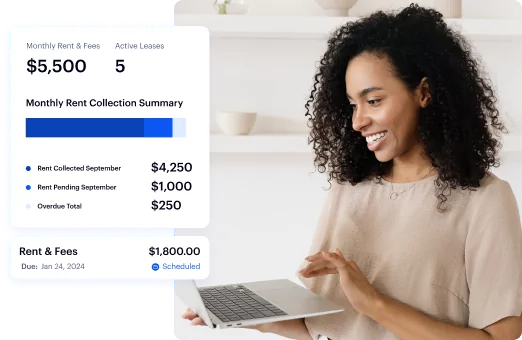Managing multi-family properties presents unique challenges, requiring efficient systems to handle multiple units, tenants, and complex finances. The right multi-family property management software can streamline operations, reduce costs, and improve profitability. This guide explores what this software entails, its benefits, essential features, and top platforms to consider for 2025.
Key takeaways
- Multi-family property management software centralizes operations for buildings with multiple units.
- Adoption is increasing due to the need for automation and efficiency gains.
- Key features include comprehensive accounting, online rent collection, and detailed reporting.
- Software offers significant advantages over manual methods like spreadsheets.
- Costs typically range from $1 to $5 per unit per month.
What is multi-family property management software?
Multi-family property management software is a specialized platform designed to manage properties containing multiple rental units within a single building or complex. Unlike software for single-family homes, it offers features tailored for scale and bulk management.
This includes unit-level tracking, shared building expenses, and streamlined processes across numerous tenants. It serves as a central hub for managing diverse operational aspects.
Why use multi-family property management software
Landlords and investors managing multi-family properties benefit significantly from dedicated software. The global property management software market is projected to grow, with the multi-family sector showing a strong CAGR of 16.3% from 2025 to 2032. This growth is driven by the critical need for automation to enhance efficiency and accuracy. Using software helps reduce manual errors and saves costs across various tasks.
Implementing robust rental property management software provides numerous benefits for investors. These include enhanced transparency into finances and operations, improved compliance with regulations, and better risk management. Ultimately, software helps landlords and investors gain control and improve the overall tenant experience across their units.
Must-have features for multi-family software
Effective multi-family property management software must offer a comprehensive suite of features tailored to the complexities of managing multiple units. Look for platforms that integrate financial management with operational workflows. This integration is crucial for saving time and gaining clarity.
Essential features include:
- Core Accounting: The ability to track income and expenses by property and unit is vital. This includes managing rent payments, operating costs, and generating financial reports like income statements.
- Online Rent Collection: Automated invoicing, payment tracking, and options for tenants to pay via ACH or card simplify receiving rent from numerous tenants. Automated late fees and reminders reduce manual chasing. Platforms like Baselane offer seamless rent collection integrated with banking and bookkeeping.
- Automated Billing Software: Essential for handling recurring charges like rent, utilities, and HOA fees across multiple units. Helps eliminate missed payments, improves cash flow, and reduces manual work.
- Tenant Portal: A dedicated portal allows tenants to view statements, make payments, and submit maintenance requests online. This improves communication and provides a better experience for residents.
- Maintenance Tracking: Systems for tenants to submit repair requests and for landlords to manage, assign, and track work orders across multiple units are essential. This ensures timely repairs and keeps records organized.
- Leasing & Screening: Tools for online applications, integrated tenant screening (credit and background checks), and potentially lease creation help streamline the onboarding process for new tenants.
- Reporting & Analytics: Access to financial reports, occupancy reports, and property performance analytics provides crucial insights for decision-making. Customizable reports allow investors to track key metrics relevant to their portfolio.
Top multi-family property management software platforms in 2025
The market offers various software options catering to different portfolio sizes and needs. Identifying the right platform requires evaluating features, scalability, and pricing. Below are some of the leading platforms researched for multi-family properties in 2025. Consider which set of tools best aligns with your specific investment strategy.
Baselane
Baselane is designed for independent landlords, particularly those with small to medium multi-family portfolios. It offers integrated banking, bookkeeping, and rent collection tools.
Its strength lies in simplifying financial management with features like unlimited banking accounts for easy property organization and automated transaction tagging. Baselane aims to provide a user-friendly solution to help landlords save time and gain financial clarity.
DoorLoop
DoorLoop targets landlords and property managers across various portfolio sizes, including multi-family units. It provides a comprehensive suite covering accounting, tenant communication, maintenance tracking, and leasing. Its pricing is unit-based with a minimum requirement. DoorLoop is often noted for its ease of use and wide range of features suitable for growing portfolios.
AppFolio
AppFolio is a well-known platform primarily serving medium to large property management businesses and landlords. It offers robust accounting, marketing, leasing, and maintenance functionalities. While powerful, its features and higher minimums may be more suitable for larger multi-family operations. AppFolio provides extensive reporting capabilities.
Rentec Direct
Rentec Direct caters to small to medium-sized landlords and property managers. It includes core features like online rent collection, accounting, and tenant screening. Its pricing is typically tiered based on the number of units. Rentec Direct offers a balance of essential tools for smaller multi-family portfolios.
Yardi Breeze/Voyager
Yardi offers solutions ranging from Yardi Breeze for small to medium properties to Yardi Voyager for enterprise-level portfolios. These platforms provide extensive features for large-scale multi-family management, including sophisticated accounting and operational tools. Yardi products are generally designed for larger or more complex operations.
Comparison between multi-family property management software
Selecting the best software depends heavily on your portfolio size, budget, and specific needs. Here is a comparative look at features across different platforms. Understanding the differences in target size and core offerings is key.
| Feature | Baselane | DoorLoop | AppFolio | Rentec Direct | Yardi Breeze/Voyager |
|---|---|---|---|---|---|
| Target Portfolio Size | Small to Medium | Small to Large | Medium to Large | Small to Medium | Medium to Enterprise |
| Pricing Model | Transparent, unit-based | Unit-based with minimum | Unit-based with higher minimum | Tiered unit pricing | Varies, often higher minimum/enterprise |
| Core Accounting | Yes, designed for rentals | Yes, full suite | Yes, robust | Yes, includes trust accounting | Yes, very robust |
| Online Rent Collection | Yes, multiple payment options | Yes, multiple payment options | Yes | Yes | Yes |
| Tenant Portal | Yes, for communication & payments | Yes, full-featured | Yes | Yes | Yes |
| Maintenance Tracking | Yes, request & work order management | Yes, comprehensive | Yes | Yes | Yes |
| Leasing & Screening | Yes (applications, screening) | Yes (apps, screening, eLeasing) | Yes | Yes (screening tools) | Yes |
| Reporting & Analytics | Yes, financial & property reports | Yes, customizable reports | Yes, comprehensive reporting | Yes, standard reports | Yes, advanced analytics |
| Mobile App | Yes | Yes | Yes | Yes | Yes (varies by product) |
| Ease of Use | Designed for simplicity | High | Moderate (feature-heavy) | Moderate (UI can feel dated) | Varies (Voyager is more complex) |
This table highlights how different platforms cater to distinct segments of the multi-family market. Baselane’s focus on integrated financials makes it suitable for independent landlords prioritizing streamlined bookkeeping and banking alongside rent collection. Other platforms offer broader or more enterprise-level features.
Multi-family property management software vs spreadsheet
Many landlords begin managing their multi-family properties using manual methods like spreadsheets or basic accounting software. While seemingly cost-effective initially, these methods quickly become inefficient as the portfolio grows. Managing multiple units manually requires significant time for data entry, tracking rent payments, reconciling bank accounts, and generating reports. Errors are also more likely, leading to potential financial discrepancies and compliance issues.
Dedicated multi-family software automates many of these repetitive tasks. This saves significant time and reduces the risk of human error. For instance, automating rent collection ensures timely payments and accurate tracking across all units. Integrated bookkeeping auto-categorizes transactions, drastically simplifying financial management compared to property management spreadsheets. The investment in software pays off through increased efficiency, improved accuracy, and better insights into property performance, which manual systems struggle to provide at scale. Ultimately, it shifts focus from busywork to growth.
Pros and Cons of Multi-Family Property Management Software
Implementing multi-family property management software offers distinct advantages and disadvantages. Understanding these can help landlords and investors make an informed decision. The benefits often outweigh the drawbacks, especially for growing portfolios.
Here are some key pros and cons:
Pros
- Increased efficiency through automation of tasks like rent collection, bookkeeping, and maintenance tracking.
- Improved accuracy and reduced errors compared to manual systems.
- Enhanced financial visibility and reporting for better decision-making.
- Streamlined tenant communication and maintenance request management via dedicated portals.
- Better organization of data across multiple properties and units.
Cons:
- The initial cost for subscription fees can vary significantly between platforms.
- Time required for initial setup, data migration, and learning the new system.
- Potential complexity of features, especially with enterprise-level software.
- Dependency on the software provider for updates and support.
Despite potential challenges like initial setup, the long-term benefits of automation and improved organization are substantial for multi-family landlords.
How to choose the right multi-family property management software
Choosing the best multi-family property management software requires careful consideration of your specific needs and goals. Not all software is created equal, and what works for a large property management company may not suit an independent landlord. Focus on platforms that offer a balance of necessary features and ease of use.
Consider portfolio size
Some software platforms are designed for large portfolios with complex needs (like Yardi Voyager or AppFolio). Others, like Baselane or Rentec Direct, are more tailored for property management for small landlords and those with medium-sized multi-family holdings. Ensure the software can scale with your potential growth, but isn’t overly complicated for your current number of units.
Look into how many units a platform supports and what the pricing looks like as you add more properties.
Evaluate essential features
Create a list of the non-negotiable features you need, such as online rent collection, integrated accounting, and maintenance tracking. Review the capabilities of different platforms against this list.
Pay attention to features specifically beneficial for multi-family, like the ability to easily track income and expenses per unit or manage shared building costs. Consider integrated solutions that handle multiple functions from one dashboard.
Understand pricing models & total cost
Software pricing models vary (per unit, tiered, flat fee). Calculate the potential cost based on your current and projected unit count. Ask about setup fees, training costs, and any extra charges for premium features like tenant screening or online payments.
Compare the total cost of ownership across different platforms. Cloud-based solutions often have lower upfront costs but ongoing subscription fees. The average cost is typically between $1 and $5 per unit per month.
Look for ease of use & support
The most powerful software is only effective if you can use it efficiently. Look for a platform with an intuitive interface and good customer support. Read reviews and consider requesting a demo or trial to test usability yourself. Reliable support is crucial for troubleshooting issues and maximizing the software’s potential. Baselane is designed for simplicity, aiming to be user-friendly for landlords.
Online banking, rent collection, accounting, and more—all in one place.
Multi-family property management software cost in 2025
The cost of multi-family property management software can vary significantly depending on the provider, features included, and the number of units you manage. Most cloud-based platforms utilize a per-unit pricing model or tiered plans based on unit count. Average costs generally range from $1 to $5 per unit per month for standard solutions. Enterprise-level software for very large portfolios can have much higher costs and often require custom quotes.
Beyond the core subscription fee, consider potential additional costs.
These might include one-time setup fees, costs for premium features (like extensive tenant screening or advanced reporting), or fees for specific transaction types (e.g., credit card payment processing). Some platforms may also charge for additional users or dedicated customer support options.
Baselane offers a transparent pricing model, typically unit-based, without hidden fees, which is beneficial for independent landlords managing costs closely. When evaluating options, get a clear breakdown of all potential expenses to understand the total investment.
How to claim software costs back
For landlords and real estate investors, the cost of property management software is typically considered a deductible business expense. This can include both the initial setup fees and ongoing subscription costs. These expenses are generally classified under operating expenses related to the rental property business.
Consult with a tax professional to understand how these costs apply to your specific tax situation and jurisdiction. Accurate record-keeping of software expenses is essential for tax purposes.
Bottom line
Choosing the right multi-family property management software in 2025 is a strategic decision for any landlord or investor aiming to optimize their operations. Software automation provides significant time and cost savings compared to manual management methods.
Key features like integrated accounting, online rent collection, and maintenance tracking are essential for managing multiple units effectively. Platforms range from user-friendly solutions for small portfolios, like Baselane, to robust systems for large enterprises.
Evaluate your portfolio size, feature needs, and budget to find the best fit. Implementing software helps improve efficiency, gain financial clarity, and ultimately grow your real estate business. By leveraging the power of technology, multi-family landlords can focus less on administrative burdens and more on strategic investment decisions.
Selecting the right tool is an investment in the profitability and scalability of your multi-family portfolio. Consider integrated platforms that centralize your financial management.
FAQs
Multi-family property management software is designed specifically to manage properties with multiple rental units in a single building. It helps streamline operations like rent collection, maintenance, and accounting across all units. It differs from single-family software by offering features for bulk management.
Software automates tasks, reduces errors, and provides integrated features like online rent collection and tenant portals that spreadsheets cannot. It saves significant time and offers better financial reporting and organization for multiple units.
Costs typically range from $1 to $5 per unit per month for cloud-based solutions. Pricing models can vary and may include additional fees for setup or premium features. Enterprise software for very large portfolios costs more.
Yes, many platforms, like Baselane or Rentec Direct, offer plans tailored for independent landlords with smaller multi-family portfolios. They provide essential features without the complexity or cost of enterprise systems. Look for options designed for ease of use.
Yes, a key feature of effective multi-family software is the ability to track income and expenses specifically for each unit within a property. This allows for detailed financial analysis per unit and overall property performance.









